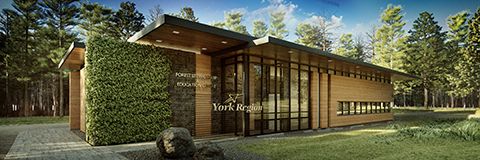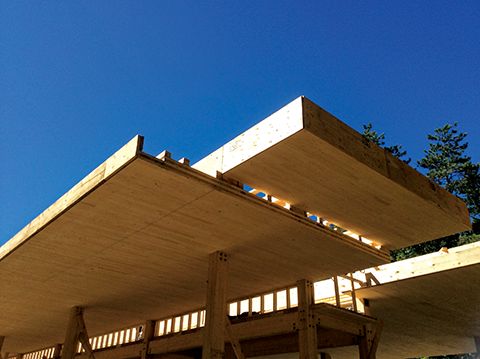Creating a regenerative building in Southern Ontario

By Craig Applegath, PPOAA, AIBC, FRAIC, LEED AP, and Charles Marshall, P.Eng., LEED AP
What if a building could function like a forest? What if a project could be designed so it was an integral part of nature and enhanced its surroundings? This was the approach taken by the design team for the York Region
Forest Stewardship Education Centre (YRFSEC)—a new single-storey, 371-m2 (4000-sf) building located in the middle of one of Southern Ontario’s natural treasures.
In order to become part of the ecosystem and not disturb the area’s natural beauty, the design team saw the need for integration in four key areas:
- Energy: The facility would have to run on only clean energy provided by wind and the sun, generating no pollution or greenhouse gas (GHG) emissions;
- Water: It would have to capture rainwater, returning it to the watershed cleaner than when it arrived;
- Place: It would have to be uniquely rooted in its place, reflecting the natural landscapes that surround it; and
- Design: It would have to provide delight and wonder, inspiring all who visit it and reinvigorating the connection to the natural world.
These four pillars were the foundation for the YRFSEC. This project targets the highest level of green building—including Platinum certification under Leadership in Energy and Environmental Design (LEED) and meeting all petals of the Living Building Challenge (LBC)—and explores the boundaries of regenerative design, working to restore and enhance the world around it.
Welcome to the forest
York Region’s Department of Natural Heritage and Forestry is responsible for the management of 21 tracts of forest located on the Oak Ridges Moraine, a sprawling geographical feature that is one of Ontario’s most important ecological and hydrological networks. The Hollidge Tract is an 80-ha (197-acre) patch of responsibly managed forest and trails outside of the town of Whitchurch-Stouffville. The forest’s unique history provides an example of humanity’s ability to destroy and restore the natural world.
In the late 1800s, the lands were cleared for agriculture. However, the sandy soils of the moraine proved ill-suited for farming. After the turn of the century, the farms were abandoned, leaving behind a northern desert covered in eroded soils and
sand dunes.

In 1924, the province of Ontario purchased the Hollidge Tract and began a decades-long process of restoration. Red pines were planted to restore the soil and provide shade for other coniferous and deciduous species to grow beneath them, mimicking the native forest originally on this site. Under the care of the York Region Forestry team, the area has regrown to a healthy, maturing forest, providing habitat for countless species of plants and animals, as well as a network of trails where visitors can exercise and experience the wonder of the outdoors. Today, the site is a living example of how people can partner with nature to improve and enhance the land.
The Hollidge Tract is home to ‘Nature’s Classroom,’ a program where visitors can learn not just about the forest, but also about the complex relationship between people and the natural world. The existing Education Centre was small and had outlasted its useful service life; by 2011, plans for its replacement were developing.
York Region aspired to create a new space that would function as a home for equipment and training while also serving as an education centre and hub for community outreach. They also wanted the new YRFSEC to reflect the heritage of the Hollidge Tract and demonstrate a legacy of stewardship and regeneration intended to continue for another 90 years and beyond.









